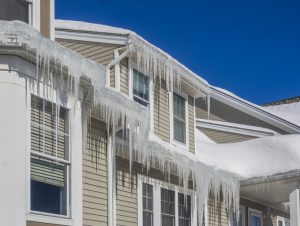 Ice dams are a serious problem for homeowners. They’re nearly impossible to predict, they’re tough to remove if left alone too long, and they can cause massive damage to your home. They only occur during winter, but the freezing temperatures and severity of northern winters make the threat of ice dams a constant worry for homeowners.
Ice dams are a serious problem for homeowners. They’re nearly impossible to predict, they’re tough to remove if left alone too long, and they can cause massive damage to your home. They only occur during winter, but the freezing temperatures and severity of northern winters make the threat of ice dams a constant worry for homeowners.
Causes
To know how to remove these ice dams, we first need to establish what causes them. In simple terms, an ice dam is a build-up of ice on a roof, typically in a valley or eave that causes water to pool and eventually leak into the home.
The ice dam forms from melted snow. The melted snow travels down the roof until it hits the eaves where it refreezes and begins building into an ice dam. Most ice dams occur due to poor insulation. Homes in direct sunlight or with good insulation are usually able to prevent the build-up of ice, but poorly insulated homes melt the snow from underneath, and since the eaves are not heated by warm air the ice forms.
When the water gets caught behind the ice dam is seeps under shingles or metal paneling and begins causing damage inside the home.
Prevention
These five tips will save your roof and prevent thousands in repairs.
- Ensure you have proper insulation. Your attic, ceilings, and walls need to be well insulated. As explained earlier, proper insulation will prevent ice dam formation and save you money on your energy bill.
- Clear your roof of snow. As soon as possible after a snowstorm, you need to clear your roof of snow. Depending on how heavy the snowfall is will determine the urgency of the situation. The longer you wait, the more chance ice dams have to form.
- Install heating coils. Heating coils run along the problem area and emit a low amount of heat to prevent ice formation. They’re great for taking care of hard to reach areas that consistently form ice dams.
- Buy a roof rake. Roof rakes are tools designed to scrape off roofs for snow and leaves. They feature long retractable handles so you can reach up high and scrape debris and snow from your roof. Make sure to remove the snow as evenly as possible, as uneven weight could cause damage.
- Cooldown your roof. Since ice dams are formed by warm roofs melting underlying snow, if you can cool down your attic below 32F you won’t have to deal with ice dams on such a large scale. This can be achieved by closing up attic bypasses and adding vents to the attic.
As always, if you’re worried about preventing ice dams, unable to take care of them yourself, or are simply afraid of going up on the roof, call a professional. It’s better to hire a professional then injure yourself or cause thousands in damage.
If you already have an ice dam you’ll need tools like an air compressor, pry bar, and ladder to break the ice and remove the build-up. Consult a professional and ensure you have the proper tools before attempting this.
